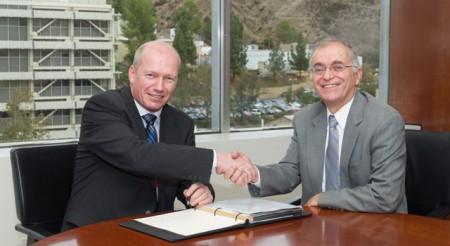 JPL Director Charles Elachi (right) and Lars Høier, Statoil Sr. Vice President, Technology
JPL Director Charles Elachi (right) and Lars Høier, Statoil Sr. Vice President, Technology Products and Drilling Research Development and Innovation, took part in a ceremonial signing
for a NASA-Statoil agreement. (Credit: NASA/JPL-Caltech)
Charles Elachi, director of NASA’s Jet Propulsion Laboratory in Pasadena, Calif., met with top executives of the Norwegian-based oil and gas company, Statoil, on Friday, Nov. 22, in a ceremonial signing of a new agreement to assist in the development and subsequent transfer of technologies to Statoil and America’s oil and gas activities.
The focus will be on enabling safe and efficient development and production of U.S. and world fossil fuel reserves.
Technologies developed by JPL for the harsh and difficult environments of space will be applied to the demanding environments of oil and gas production. The agreement also provides an opportunity for JPL to benefit from synergistic technology currently being developed in the oil and gas sector that might be used for space exploration.
Statoil has large holdings in the U.S., in such challenging environments as offshore and tight shale formations. It is number 39 on the Forbes 500 list of the world’s largest companies.
“This agreement is the latest example of how NASA and JPL technologies can benefit us here on Earth. It’s also an example of how collaborations with other industries can be beneficial to space exploration,” said JPL Director Charles Elachi.
“Searching for oil and gas resources has become so advanced technically over the past decade that new solutions and ideas are needed. To Statoil this is a significant opportunity to take technologies developed by NASA and JPL for the harsh and challenging environments of space and apply them to the equally demanding environments of oil and gas production,” said Lars Høier, Statoil acting senior vice president of research, development and innovation.
Statoil is among the most technology-intensive of major energy producers, and annually spends $550 million on research, development and innovation. The contract between Statoil and NASA is expected to run from 2013 to 2018 (with the option of contract extension), and will focus on the following research areas: supercomputing, materials, robotics, development of new tools, and communication optionality.
In addition to a general tour of JPL prior to the signing ceremony, Statoil representatives also had an opportunity to see JPL’s Microdevices Laboratory, where some of these technologies are being developed.

